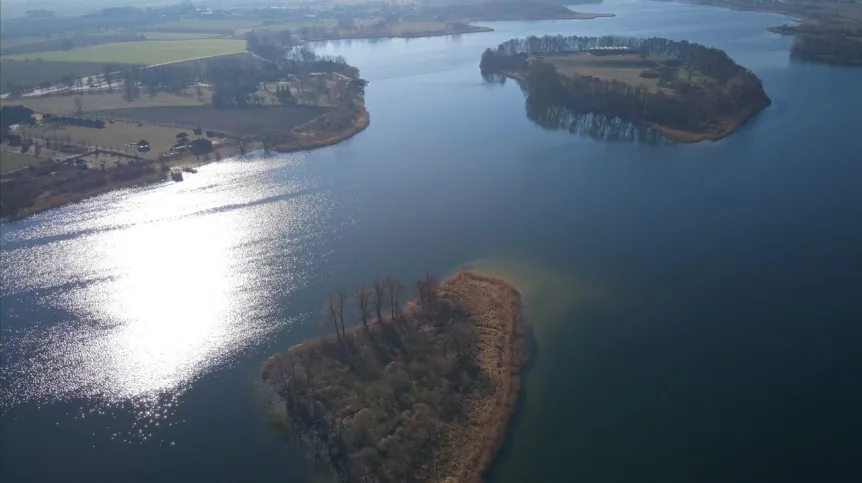
Scientists have examined the bottom sediments from Lake Lednica (Wielkopolska). The data they have obtained allow to draw conclusions about historical changes in the landscape and the development of the Piast state, including deforestation, popularisation of grain cultivation, development of settlements. The paper on the origins of the Piast state was published in PNAS.
The paper on the origins of the Piast state was published in the latest issue of "Proceedings of the National Academy of Sciences" (PNAS). It combines palaeoecological data with the findings of archaeology, history and numismatics, offering a new look at the processes accompanying the creation of the first state structures in Polish lands, the Adam Mickiewicz University in Poznań reports in a press release.
The paper is a summary of many years of collaboration between natural scientists and archaeologists from Poznań, Gdańsk and Dziekanowice with historians from Warsaw, Białystok and Berlin, and geologists from Cologne and Zurich. The research was conducted by scientists from Adam Mickiewicz University, the University of Warsaw, the University of Gdańsk, the University of Białystok, the Museum of the First Piasts in Lednica, the University of Cologne, the Free University of Berlin, the Max Planck Institute for Geoanthropology (Germany) and the Federal Institute of Technology in Zurich (Switzerland).
To determine the ecological and economic realities in eastern Wielkopolska approximately one thousand years ago, the scientists reached for a source that was not very obvious at first glance - sediments from the bottom of a lake.
The analysed sediments came from Lake Lednica - a reservoir in the middle of the early Piast centre of power. As a result of detailed studies of these sediments, the scientists obtained data that allowed them to draw conclusions about various aspects of the historical development of the region. Pollen analyses allowed to draw conclusions about changes in vegetation and land use with an accuracy of about 20 years. As the researchers emphasise, the results indicate rapid transformations of the environment in the 9th and 10th centuries, interpreted as an 'ecological revolution', which was the basis for the formation of political and military structures.
'Radiocarbon dating of the sediment core from Lake Lednica provided us with a precise time scale, enabling comparisons with historical and archaeological data', says Professor Mariusz Lamentowicz from the Faculty of Geographical and Geological Sciences of the Adam Mickiewicz University, quoted in the press release.
The vertically collected soil sample (called core), containing sediments accumulated over many decades and containing inorganic and organic matter, e.g. pollen, 'has become a key reference point for reconstructing the process of the disappearance of primeval forests around Lake Lednica and the development of settlement in this region. The new data have been compared with the results of research on peat bogs from Wielkopolska, Lubusz Land and Pomerania, conducted at high sampling and dating resolution. This has allowed us to obtain a unique picture of the dynamics of changes in the landscape and ecosystems of wetlands under the influence of the Piast state. These processes have been recorded in detail in biogenic sediments. The profile of sediments from Lake Lednica is thus a milestone in the palaeoecological research of Wielkopolska' Lamentowicz adds.
Professor Katarzyna Marcisz from the Faculty of Geographical and Geological Sciences of the Adam Mickiewicz University explains that while lake or peat sediments do not look spectacular, they contain unique information about the history of ecosystems.
'We are unable to obtain similar data using other sources because, firstly, written data do not reach back as far as the sediments accumulated in various reservoirs, and secondly, often specific changes in ecosystems have not been documented in the past in the archives available to us. Palaeoecological studies allow us to look into the past and read many aspects of ecosystem development - from changes in vegetation and hydrology, the occurrence of fires and catastrophic phenomena, to the impact of humans. Comparing information obtained from various sources enables an in-depth analysis of the data, allowing to obtain more precise environmental reconstructions', Marcisz emphasises.
The authors of the publication explain that during the life of one or two generations in the area of eastern Wielkopolska, extensive felling of oak-hornbeam forests took place and created space for intensive grain cultivation. Grain cultivation - due to its calorific value and storage and transport possibilities - was the basis for maintaining large population centres, necessary for the functioning of statehood. This process was accompanied by the development of a settlement network, concentrated around the main towns: Gniezno, Poznań, Giecz and Lednica.
The work of the scientists indicates that the genesis of the Piast state was closely linked to transregional trade processes, in particular the slave trade, conducted by the Scandinavians for Muslim recipients in Central Asia. This exchange, which intensified in the first half of the 10th century, was associated with the inflow of silver (dirhams) and contributed to the creation of conditions conducive to the consolidation of local elites.
The authors of the study also point out that 'the early Piast state operated in conditions of structural mismatch between a limited ecological base and growing territorial ambitions. The intensification of agriculture concerned a relatively small area, which contributed to the fragility of the system. Palaeoecological data indicate that after the mid-11th century there was a rapid regression in land use, a decline in crops and a renewed expansion of secondary forests', we read in the press release.
The authors of the study also point out that 'the early Piast state operated in conditions of structural mismatch between a limited ecological base and growing territorial ambitions. The intensification of agriculture concerned a relatively small area, which contributed to the fragility of the system. Palaeoecological data indicate that after the mid-11th century there was a rapid regression in land use, a decline in crops and a renewed expansion of secondary forests', we read in the press release. And although archaeology confirms the continuity of settlement, the analysis of the data proves that state structures collapsed. Greater Poland ceased to function as a political core, and its socio-ecological foundations – crucial for the success of the Piast dynasty – were permanently weakened, the authors of the publication note.

'The research described in our paper is an excellent example of how natural sciences can enrich our knowledge of ancient societies, which are the everyday subject of history and archaeology', emphasises Professor Jakub Niebieszczański from the Faculty of Archaeology of the Adam Mickiewicz University, quoted in the press release. 'As archaeologists, we often see an increase or decrease in the number of sites over time - in this case, these were settlements or smaller settlement sites. However, only when this is compared with the results of palaeoecological reconstruction, which tells us, for example, about deforestation, abrupt increases in crops or phases of forest regeneration, does it allow for comprehensive considerations on the actual dynamics of settlement processes. Our results show the institutionalisation of the use of land resources by the state that was established in a short time, but also the scale of its later crisis'.
'It is extraordinary that plant pollen allows to fill gaps in historical knowledge, reaching back to the times of the formation of the Piast state. This shows that pollen analysis, although it is an over a hundred years old method, can still +float+ over unexplored scientific problems', adds Professor Piotr Kołaczek from the Faculty of Geology and Geophysics of the Adam Mickiewicz University. (PAP)
PAP - Science in Poland
zan/ lm/













